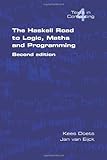I also like the Physics and Math in SICM (Structure and Interptretation of Classical Mechanics), and Scheme maps well to math equations, at least for me [2].
Julia does follow the way math is written, but I prefer Haskell. The book "The Haskell Road to Logic, Math and Programming" [3] is great, and this article on Geometric Algebra (GA) in Haskell is excellent [4].
[1] https://www.jsoftware.com/books/pdf/
[2] https://mitpress.mit.edu/sites/default/files/titles/content/...
[3] https://www.amazon.com/Haskell-Logic-Programming-Second-Comp...
Worth the purchase!
In fact, the book is even called "The Haskell Road to Logic, Maths and Programming" [0]. It covers mathematical notation, proof construction, and lots of interesting portions of discrete math that should be of interest to programmers. And large portions of the results are demonstrated or used in interesting Haskell programs.
[0] http://www.amazon.com/Haskell-Programming-Second-Edition-Com...
http://www.amazon.com/Haskell-Logic-Maths-Programming-Comput...
http://www.amazon.com/Haskell-Logic-Maths-Programming-Comput...
It's great to go over old and new math concepts and do so while exploring Haskell.
http://www.amazon.com/Haskell-Logic-Maths-Programming-Comput...


"Many of the encodings are as immutable, purely functional data structures (even in imperative languages), a topic unfortunately omitted from many computer science curricula."
Julia and similar PLs don't express math like APL, J[1], Haskell[2], Scheme[3] or even Clojure can with immutable structures and function composition to name a couple. Sure you can write it in Julia, but I don't think the article is about creating math output in the Latexify.jl example, but how to code these math structures where certain languages can express them out of the box in an easier manner.
[1] https://www.jsoftware.com/books/pdf/
[2] https://www.amazon.com/Haskell-Logic-Programming-Second-Comp...
[3] https://mitpress.mit.edu/sites/default/files/titles/content/...